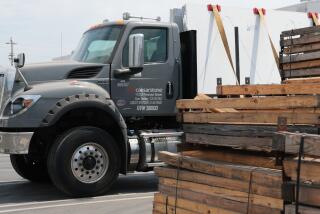Last of Old Maine Granite Quarries Keeps Alive Solid Tradition : Crafts: Four men are all that is left of an island industry that once employed thousands. But the business may be in the midst of a renaissance.
CROTCH ISLAND, Me. — Just as his father did, Ben Oliver has spent most of his adult life carving 15-ton blocks of granite from cliffs overlooking the island-dappled panorama of Penobscot Bay.
As he works, Oliver sometimes daydreams about what life was like during the years his father cut granite with a gang saw at the Crotch Island quarry. At the turn of the century, Crotch was one of 33 major island quarries along the Maine coast. They provided work for an estimated 10,000 to 15,000 people, creating a boom-town atmosphere in nearby coastal towns.
Maine granite sailed down the coast in special ships, called stone sloops, and was used in many of America’s landmark buildings.
But granite’s glory days are gone. Oliver and three co-workers are the last of Maine’s granite quarriers, and Crotch Island is the only active remnant of what once was a dominant industry and colorful part of the state’s past.
As other island quarries died with the coming of concrete, the Deer Island Quarry on Crotch survived because builders cherished the rose-tinted granite it produced.
“This is supposed to be the best granite there is,” said Oliver, who supervises the quarry for New England Stone Industries Inc. of Smithfield, R.I. “Everybody who’s ever worked with it said it’s very good granite. It breaks good, with very few cracks in it.”
Most mornings, weather permitting, Maine’s quarrying tradition is kept alive when Oliver and his colleagues--David Thompson, Richard Nevells and Richard Stinson--take a small motor boat from Stonington to Crotch Island.
“This was quite a place in the old days,” said Oliver, 49, who has worked at the quarry off-and-on for more than two decades. “About 50 years ago, they had a crew of about 200 men working on the island. They used to fabricate everything right here--cut and polish the stone right here. There were two cutting sheds right on the island.”
Now, the operation is smaller, and the granite business is slow because of the recession in the building industry. But granite has experienced something of a renaissance as builders move away from the gleaming corporate look of glass and steel to more natural facades, company officials say.
Crotch Island’s 450 acres are littered with the rusted relics of its past, and dotted with hills of waste rock, chunks of granite that didn’t break right and couldn’t be used.
“In the old days, they did use dynamite,” Oliver said. “They’d blow out a big piece and whatever they got, they got.”
A steam-powered Brownhoist crane with a 40-foot boom stands rusting near the V-shaped inlet that gives Crotch Island its name. What’s left of the island’s railway heads off into tangled brush.
One of the stonecutting sheds still stands. This summer, Oliver and his wife found a wooden box inside the building that bore his father’s initials--LMO, for Lawrence Marvin Oliver. He remembers seeing the box as a child when he’d visit his father at work on the island.
Granite quarrying began on Crotch Island in the early 1870s and, by the turn of the century, about 250 workers lived on the island, said Clayton Gross, a local historian and weekly newspaper columnist whose grandfather worked at the quarry from 1940 to 1942.
The island had two boardinghouses, a store and a school, though no one lives there today.
The town of Stonington took its name in 1897 from the quarries on Crotch Island and 10 or 15 other islands in that area of Penobscot Bay, Gross said.
“The town around 1900 had all of the characteristics of a boom town along the coast of Maine. It was just like a boom town out West, only instead of mines, they had granite,” Gross said. “There were prostitutes. There were gamblers. There were three unsolved murders on the books from the first decade of the century. It was a rather lively community.”
Granite from Crotch Island and the islands of Vinalhaven, Hurricane, Swan’s, Dix and High was used in such well-known buildings as Rockefeller Center, Chicago’s Board of Trade, the Pennsylvania Railroad Station in Philadelphia, the Boston Museum of Fine Art and the New York Stock Exchange.
“Half of New York City is Deer Island granite,” Oliver said.
But all of the quarries died off as builders began using cheaper concrete and trains replaced ships as the dominant form of transportation. All except the quarry on Crotch Island, prized for its uniquely colored granite.
The quarry was run by Deer Island Granite Corp. until 1966. It remained closed until New England Stone bought it in 1979.
The island’s stone wharf is lined with 335 granite blocks now, each weighing from 15 tons to 20 tons--about the same as 15 compact cars. The blocks were cut by Oliver and his co-workers, and are waiting to be transported by barge to Stonington.
From there, they will be trucked to the company’s finishing operations in Rhode Island. Most of the blocks will be sliced into granite veneer used for building facades, or cut into paving stones for sidewalks.
On the island, Oliver and the three others spend their days dicing slabs of granite that are larger than many houses into smaller blocks that are roughly 4 1/2 feet by 5 1/2 feet wide, and 12 feet deep.
“They basically did it the same way in the old days, but they didn’t have the equipment to work with that we do today,” Oliver said.
One recent morning, Oliver and Thompson worked atop a 50-foot granite cliff, using a track drill with three 16-foot bits to grind into the rock.
Walls of white granite rose up around them, and dozens of islands stretched out before them as the sun glinted off the bay. But the crash of the surf was drowned out by the roar of the drill.
The holes drilled into the rock outlined the shape of the smaller blocks. Later, the crew will hammer out those blocks using metal wedges and hand-held mechanical pounding tools that weigh about 80 pounds. Until a year ago, they used sledgehammers.
“It really isn’t that bad breaking it down into blocks. When we get going, we can break up 20 blocks a day,” Oliver said, grinning. “It don’t break that hard.”
More to Read
Sign up for The Wild
We’ll help you find the best places to hike, bike and run, as well as the perfect silent spots for meditation and yoga.
You may occasionally receive promotional content from the Los Angeles Times.






